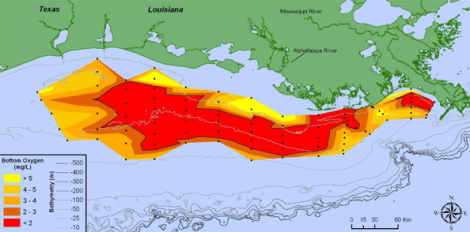Oh yay. Just 5,840 square miles of the Gulf of Mexico are virtually bereft of life this summer.

Louisiana Universities Marine ConsortiumThe deadest parts of the 2013 dead zone are shown in red. Click to embiggen.
This year’s dead zone is much bigger than an official goal of 1,950 square miles, but not as bad as had been feared.
But NOAA says things could have been worse. The agency had previously warned that this summer’s dead zone could be larger than the record-breaking one of 2002, when an 8,481-square-mile-area of low or no oxygen was detected during monitoring. Heavy winds came to the aid of the Gulf ecosystem this year, mixing up the oxygen-deprived waters and reducing the size of the dead zone.
The area of low oxygen covers 5,840 square miles of the Gulf floor — roughly the size of Connecticut — said scientists led by Nancy Rabalais of the Louisiana Universities Marine Consortium. …
Rabalais said the survey boat encountered some bottom-dwelling eels and crabs that had swum near the surface of water that’s 60 to 70 feet deep to find oxygen.
“That’s a long way for something like an eel, that lives buried in the mud, to find its way to the surface,” she said in an interview.




